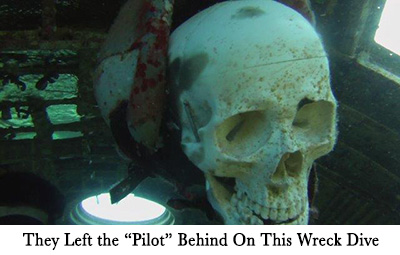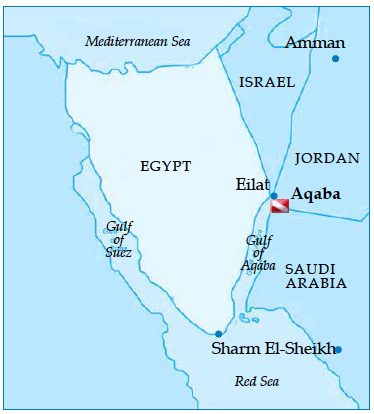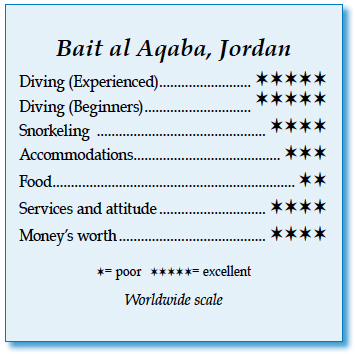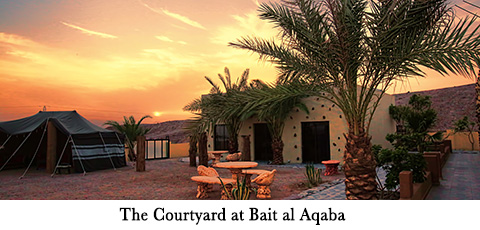Bait al Aqaba Resort, JordanContents of this Issue: Baja Charters, La Paz, Baja California Start Sending Us Your 2019 Reader Reports Getting To and Around Baja California What Is Undercurrent’s “Caribbean Scale?” The Cocos-Galapagos Swimway for Turtles and Sharks Are Those Bedbugs in Your Dive Gear? Diver Scallops? Give Me a Break A Huge Great White Shark Controversy New Zealand Just Banned Cage Diving with Sharks Discover Scuba Diving Is Deadly “Traditional” Fins Are Making a Comeback Our Shocked and Appalled Readers Reef Safe Sunscreen Isn’t Safe -- And Its Maker Doesn’t Care Editorial Office: Ben Davison Publisher and Editor Undercurrent 3020 Bridgeway, Suite 102 Sausalito, CA 94965 a Red Sea site worth seeking out for its wreck diving from the February, 2019 issue of Undercurrent
Dear Fellow Diver: Imagine a skeleton in workman's clothes sitting in the cockpit of a sunken Lockheed C-130 Hercules plane, one bony hand on the throttles. Would you travel to the Middle East to see that on a dive? I did last October, venturing to Aqaba, the only town on Jordan's patch of Red Sea coast. Crystal-clear visibility made it easy for me to spot the Hercules on a sandy bottom at 53 feet, surrounded by triggerfish, scorpionfish, puffers and tiny red anthias. The four-engine, turbo-prop troop carrier aircraft was sunk purposely, political slogans still scribbled on it, in September 2017, its doors left open for penetration and propellers removed. It was easy to enter its fuselage and swim all the way to the cockpit.
I immediately knew I was in the Middle East when I saw strict security on my way from the hotel in Amman, Jordan's capital, to the airport for a short morning hop to Aqaba -- my taxi had to pass through two military checkpoints filled with soldiers carrying automatic weapons. They checked the trunk, looked under the car, even sent a dog around sniffing for explosives. But that all made me feel safe, and I never lost that feeling while traveling through Jordan, which is bordered by Israel, Syria, Iraq and Saudi Arabia. The travel agent I used had recommended Bait al Aqaba Resort, a small, mediocre beachfront place in Aqaba's South Beach area, a 10-minute drive from downtown. I wanted to be where the dive action is -- South Beach is home to the Marine Park, the tank, the plane and most of the wrecks. Higher-end beachfront hotels and resorts are located on Aqaba's northern end, and dive shops pick up divers there. Why I had a "shore dive" package with Bait al Aqaba when the other dive centers marketed trips on their boats in the town's harbor puzzled me. Muhannad, the 35-year-old local who manages Bait al Aqaba's dive center, gave this explanation: Their boats dive the same sites we do here from shore, they're more expensive, and you save more time and money by skipping the 10-minute taxi drive that costs five Euros each way to and from the harbor. So, I donned my dive gear at the center (I was the only diver that week) and rode in their pickup truck along the sandy gravel beach. We reached most sites this way in under 15 minutes.
From 100 feet, we ascended to the Cedar Pride, a 242-foot-long cargo vessel that caught on fire while moored in Aqaba in 1982. (It was sunk three years later at a site selected by Jordan's King Abdullah II, an avid diver himself.) Lying on her port side on two reef platforms, bow facing north, she's a beautiful wreck with easy penetration; I found many spots where air was trapped between holds. Soft coral growth on the mast and masthead, which rises up to 22 feet, provided excellent photo opportunities. A turtle cruised past as I poked around winches and gear in the still-intact bridge and forecastle; the big propeller is still on. Open spaces in between the reef platforms made it easy to swim under her hull to the other side. Muhannad spotted a hairy frogfish inside one of the holds and signaled me to please please photograph it. Unfortunately, using a Hero camera without extra lights gave poor results. Coming to shore from that dive, I took an eight-minute walk from the beach to Bait al Aqaba Resort, which sits on a small slope rising up to the inland mountains. My double room was basic but comfortable, with a small fridge and widescreen TV. The small bathroom just had a showerhead in one corner, next to the toilet (Undercurrent editor John Bantin explains that Easterners, who think Westerners are dirty because they wipe their backsides with paper, instead wash with a showerhead and use paper to simply dry themselves before placing it in the trash). I had no place to hang my wet gear, other than hangers in a corner. It wasn't a quiet setting -- for my first three days, Jordanian pop music blared over speakers by the pool from early afternoon till 10 p.m. I chatted with German divers who, like me, were happy with the diving but not the accommodations.
Aqaba's coastal area is officially a marine park. To me, that means a place tgat is protected from overfishing and dumping garbage. That's not what it means here. When Muhannad took me to Tala Bay, I saw not only a beach, but a reef littered with garbage. So many fishing lines were scattered among the reef, it looked like some woolen weaving maze. In the sea grass, I found cans, bottles, plastic animal toys and other things that didn't belong there. Muhannad suggested a cleanup, which all the dive centers sometimes do together, and I offered to join the free-of-charge dive. Two 11-year-old German kids and I filled up 12 bags of stuff in no time. I was responsible for cutting the fishing lines with a knife, but I often didn´t know where to start first, there were so many lines with hooks entangled in the coral. Aqaba's "marine park" is an utter shame. However, at the site Electric Cable, I found a big patch at 78 feet covered with mesh fencing, put there by the local dive centers and marine biologists to aid coral growth and reproduction. Tiny beginnings of all types of coral species were springing forth. The place was a kindergarten for sea life regularly seen on the reefs, from puffers and octopuses to scorpionfish and stonefish. Most of Aqaba's 25 dive sites were a mixture of sandy patches, with seahorses hiding in seagrass, and blocks of hard coral reef sloping down into canyons starting at 100 feet. Visibility was typically 100 feet, and with water temperatures averaging 79 degrees, I could get away with a hoodless 5-mil wetsuit. While there was medium-sized life, such as crocodilefish, coral groupers and crown butterflies, flitting around coral in the three- to 10-foot range, their numbers got alarmingly less as I went deeper. Still, the sites offered excellent photo ops -- Muhannad pointed out some praline nudibranchs, and I found a few cleaner shrimps and seahorses. The dive shop was a gem. Cozy couches and chairs made the huge front room an inviting place to hang out, and there were separate spaces for the compressor room, changing room, a small classroom, a separate workroom, and plenty of showers and toilets. But Type A divers, be prepared: Everything runs in slow-motion in Jordan. A "suggested" meeting time of 9 a.m. often turned into 9:30. When customers asked for snorkeling gear and site suggestions, it easily turned to 10 a.m. Muhannad and his staff did all the necessary jobs themselves, but because I was often the first one there in the morning, I assembled my gear, took tanks from the compressor room, even loaded gear into the pickup. After the dives, they took over and cleaned everything properly in tubs. Photographers would find it hard to get their gear properly handled; the dive shop didn't make an effort to cater to them. But everything stops when royalty calls. Midweek, an email went to all dive centers: Cedar Pride and the Hercules C 130 dives were off limits that morning. King Abdullah planned to do some diving, so no tourist divers allowed.
I had more luck with the Shorouk. We agreed on the same dive plan: down to 130 feet for a couple of minutes. Again, it looked as if we wouldn't find it. Then out of the blue, there it was. Nothing special, though -- a long, empty wreck with bubblegum- pink soft coral forming around the railings. We still ended with 20 minutes deco, and Muhannad had to use the pony tank. He told me later he loves that wreck -- I'll have to take his word for it. Muhannad seems to be the driving force behind Aqaba's efforts to boost eco-friendliness, and he constantly talked with the other dive centers about how to make Aqaba more appealing for divers. This resort town is not a big draw for non-divers or snorkelers -- the nearest worthy attractions are one to two hours away. I used an Aqaba travel agent to plan some day trips -- to the ancient Greek city of Petra, where the third "Indiana Jones" film was shot, then to the dramatic desert landscape of Wadi Rum, featured in Lawrence in Arabia. A German woman diver also staying at Bait al Aqaba Resort was interested in visiting there, so we split the 100-Euro cost for a two-hour cab ride to Petra, which resembles a small version of the Grand Canyon. With tombs and temples dating back to 300 B.C. carved into pink sandstone cliffs, it surpasses the glamour of Egypt's pyramids. Wadi Rum, an hour's drive from Aqaba, is a psychedelic desert, with multi-colored sands and weird rock formations. After a three-hour trip on a four-wheel-drive truck (there are camel caravans, but they moved too slowly for me), I climbed up a sand dune, only to find how difficult that really is -- Peter O'Toole was more graceful than I when he did it in Lawrence in Arabia. I did meet a bunch of American tourists in both places, but no one was there to go diving. However, Jordan's dive sites are indeed worth visiting. And Aqaba offers relaxing diving, great visibility, colorful fish life and plenty of wrecks at various depths. For those who want a hotel that better caters to Western tastes, there are places like the DoubleTree and the InterContinental near the city center, and I'd use another dive shop, such as Sinai Divers or Red Sea Divers, to book boat dives to shallow offshore reefs I had heard about later (I couldn't find any boats that went farther). This stretch of Red Sea is off-the-beaten-path diving for most North Americans, but based on the low cost and the underwater offerings, I recommend it. -- M.J. Our Undercover Diver's Bio: Mike Nelson in Sea Hunt inoculated me with the dive virus when I was 17. I followed all his adventures on TV and saw myself one day in the future diving into the deep blue in a silvery wetsuit with those two hoses and big tube regulator. Diving since 1974, I've made more than 2,200 dives in more than 100 destinations worldwide. I'm always looking for special destinations that have 'icing on the cake' dives like Phoenix Island, Kiribati, Rowley Shoals, Djibouti and New Calendonia. I'm still dreaming of visiting Bikini Atoll and Yemen."
|

I want to get all the stories! Tell me how I can become an Undercurrent Online Member and get online access to all the articles of Undercurrent as well as thousands of first hand reports on dive operations world-wide
| Home | Online Members Area | My Account |
Login
|
Join
|
| Travel Index |
Dive Resort & Liveaboard Reviews
|
Featured Reports
|
Recent
Issues
|
Back Issues
|
|
Dive Gear
Index
|
Health/Safety Index
|
Environment & Misc.
Index
|
Seasonal Planner
|
Blogs
|
Free Articles
|
Book Picks
|
News
|
|
Special Offers
|
RSS
|
FAQ
|
About Us
|
Contact Us
|
Links
|
3020 Bridgeway, Ste 102, Sausalito, Ca 94965
All rights reserved.

 Seeing a skeleton (which, by the way, is plastic) in a cockpit was temptation
enough for me to visit Jordan, but Aqaba, a quiet resort town at the Gulf of Aqaba's
northern end a few miles from the Israel border, had other easy-to-access wreck dives
(including one to a tank). And it's a dive destination that's easy on the retirement
budget -- my two-week-long hotel package of 10 shore dives and "half board" (breakfast
and dinner are included) cost around
US$1,900.
Seeing a skeleton (which, by the way, is plastic) in a cockpit was temptation
enough for me to visit Jordan, but Aqaba, a quiet resort town at the Gulf of Aqaba's
northern end a few miles from the Israel border, had other easy-to-access wreck dives
(including one to a tank). And it's a dive destination that's easy on the retirement
budget -- my two-week-long hotel package of 10 shore dives and "half board" (breakfast
and dinner are included) cost around
US$1,900. After a buddy check, Muhannad and I
walked into the 79-degree waters for a dive
at the photogenic Cedar Pride wreck, 425 feet from shore. With 100-foot visibility, a
lovely hard coral garden quickly appeared in front of me, colorful juveniles darting
about. With no tides or currents on any dive, it was easy to make my way to volcanolike
sand structures surrounded by Red Sea regulars. Orange and purple anthias swarmed
around the coral heads, and the lionfish that stalk them. Porcupinefish and lazy giant
puffers lolled on sandy parts of the seabed. Ubiquitous yellow anemonefish, despite
their diminutive size, rushed out of their anemones to ward off any perceived threat.
After a buddy check, Muhannad and I
walked into the 79-degree waters for a dive
at the photogenic Cedar Pride wreck, 425 feet from shore. With 100-foot visibility, a
lovely hard coral garden quickly appeared in front of me, colorful juveniles darting
about. With no tides or currents on any dive, it was easy to make my way to volcanolike
sand structures surrounded by Red Sea regulars. Orange and purple anthias swarmed
around the coral heads, and the lionfish that stalk them. Porcupinefish and lazy giant
puffers lolled on sandy parts of the seabed. Ubiquitous yellow anemonefish, despite
their diminutive size, rushed out of their anemones to ward off any perceived threat. The restaurant has a few outdoor tables near the pool with a sea view. Breakfast
on my first morning was a shock -- a scrambled or fried egg swimming in oil, some
strange sausage, two kinds of cheese, paprika-sprinkled tomatoes, thin pancake-like
things to wrap everything in, and a tiny cup of Turkish coffee. They never offered
fruits, juice, cereal or yogurt. Apparently, the staff had misread -- or not read -- my travel agent's note about my gluten-free
requirements. I wondered, "Will I survive
this?" On the second day, the kitchen substituted
jam instead of eggs for the gluten-free
bread I brought with me. On the third day,
they found some Nescafe, and Muhannad brought
cappuccino packages from town. Most times I
just made myself tea, as it was always at
least 8 a.m. before someone got started in
the kitchen. Lunch and dinner often were fries
served with breaded and fried fish or meat. A
couple of times, I got lucky, with delicious
meatballs in tomato sauce, or tasty grilled,
marinated meat over rice. Once I took a short
cab ride downtown, then meandered the streets
and shops in the town center and lucked out
at a hole-in-the wall restaurant that served a
delicious chicken lunch and baklava for less
than US$10.
The restaurant has a few outdoor tables near the pool with a sea view. Breakfast
on my first morning was a shock -- a scrambled or fried egg swimming in oil, some
strange sausage, two kinds of cheese, paprika-sprinkled tomatoes, thin pancake-like
things to wrap everything in, and a tiny cup of Turkish coffee. They never offered
fruits, juice, cereal or yogurt. Apparently, the staff had misread -- or not read -- my travel agent's note about my gluten-free
requirements. I wondered, "Will I survive
this?" On the second day, the kitchen substituted
jam instead of eggs for the gluten-free
bread I brought with me. On the third day,
they found some Nescafe, and Muhannad brought
cappuccino packages from town. Most times I
just made myself tea, as it was always at
least 8 a.m. before someone got started in
the kitchen. Lunch and dinner often were fries
served with breaded and fried fish or meat. A
couple of times, I got lucky, with delicious
meatballs in tomato sauce, or tasty grilled,
marinated meat over rice. Once I took a short
cab ride downtown, then meandered the streets
and shops in the town center and lucked out
at a hole-in-the wall restaurant that served a
delicious chicken lunch and baklava for less
than US$10. The Al Shorouk and the Taiyong are two deeper wreck dives I had first seen in the
brochure that made me want to visit Aqaba. However, as both lie at 200 feet, they are
technical dives. I had to beg Muhannad to dive these wrecks, as this might be my only
visit to Jordan. I promised not to go deeper than 130 feet; the upper structure of the Taiyong, a crane barge, rises up to 124 feet. "Both sites mean a hell of a long swim,"
Muhannad warned. He recommended nitrox, and to be safe, he brought two pony tanks for
us as backups. We swam from shore to the site, so as not to lose bottom time. On the
surface, he showed me a dive boat offshore that we had to reach. Hearing that boat's
generator underwater, I slowly dropped deeper and looked around, expecting to spot
the Taiyong. Twenty-five minutes later, swimming along a downward-sloping reef at 120
feet, I still did not see the boat. My computer went into deco. I gave Muhannad the X
sign to abort. He signaled for me to stay there, while he went deeper to look around.
No luck. (Later, I asked him, "What should I have been doing in case you had a problem
down there?") On our swim back, we hit the wreck of the Tarmac, a smaller barge, but
at least I could call this a wreck dive. The hold was filled with banded coral shrimp,
while frogfish and blue-spotted stingrays wandered outside.
The Al Shorouk and the Taiyong are two deeper wreck dives I had first seen in the
brochure that made me want to visit Aqaba. However, as both lie at 200 feet, they are
technical dives. I had to beg Muhannad to dive these wrecks, as this might be my only
visit to Jordan. I promised not to go deeper than 130 feet; the upper structure of the Taiyong, a crane barge, rises up to 124 feet. "Both sites mean a hell of a long swim,"
Muhannad warned. He recommended nitrox, and to be safe, he brought two pony tanks for
us as backups. We swam from shore to the site, so as not to lose bottom time. On the
surface, he showed me a dive boat offshore that we had to reach. Hearing that boat's
generator underwater, I slowly dropped deeper and looked around, expecting to spot
the Taiyong. Twenty-five minutes later, swimming along a downward-sloping reef at 120
feet, I still did not see the boat. My computer went into deco. I gave Muhannad the X
sign to abort. He signaled for me to stay there, while he went deeper to look around.
No luck. (Later, I asked him, "What should I have been doing in case you had a problem
down there?") On our swim back, we hit the wreck of the Tarmac, a smaller barge, but
at least I could call this a wreck dive. The hold was filled with banded coral shrimp,
while frogfish and blue-spotted stingrays wandered outside. Divers Compass: Bait al Aqaba offers a package of 10 dives for $275;
the resort does offer boat dives, with a two-tank day dive at $140,
but it sits right offshore the main diving draws . . . Two British
dive travel agencies, Dive Worldwide and Responsible Travel, regularly
offer Jordan dive packages, and their toll-free numbers in the U.S.
are respectively 800-972-3980 and 866-821-6866. . . One Jordanian dinar is currently around USD$1.40 . . . Jordan issues a 30-day visa to U.S. citizens for a
$56.50 fee, payable upon arrival at most international ports of entry and land border
crossings . . . There's a road crossing to the Israeli resort town of Eilat, and ferry
service to Taba, an Egyptian resort south of Eliat, which is where you'd have to book a
liveaboard if you want to dive southward in the Gulf of Aqaba; there's no diving on the
Saudi Arabia side of the Gulf . . . my two-hour cab ride to Petra cost $114 (there are
also public buses to and from Aqaba), and I paid a $68 entry fee and $35 for a tour
guide . . . Websites: Bait al Aqaba Resort -
Divers Compass: Bait al Aqaba offers a package of 10 dives for $275;
the resort does offer boat dives, with a two-tank day dive at $140,
but it sits right offshore the main diving draws . . . Two British
dive travel agencies, Dive Worldwide and Responsible Travel, regularly
offer Jordan dive packages, and their toll-free numbers in the U.S.
are respectively 800-972-3980 and 866-821-6866. . . One Jordanian dinar is currently around USD$1.40 . . . Jordan issues a 30-day visa to U.S. citizens for a
$56.50 fee, payable upon arrival at most international ports of entry and land border
crossings . . . There's a road crossing to the Israeli resort town of Eilat, and ferry
service to Taba, an Egyptian resort south of Eliat, which is where you'd have to book a
liveaboard if you want to dive southward in the Gulf of Aqaba; there's no diving on the
Saudi Arabia side of the Gulf . . . my two-hour cab ride to Petra cost $114 (there are
also public buses to and from Aqaba), and I paid a $68 entry fee and $35 for a tour
guide . . . Websites: Bait al Aqaba Resort - 